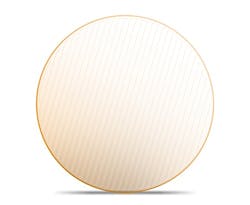Diffractive laser holes increase shelf life of packaged produce
LASER COMPONENTS (Olching, Germany), manufacturer of components and services for the laser and optoelectronics industry, describes how laser-created microholes keep packaged produce fresher. The holes are created using a diffractive optical element (DOE), an optical device that can convert a single laser beam into multiple beamlets in a prescribed pattern to meet a particular application requirement.
Diffractive optical elements (DOEs) allow laser beams to be split, bundled, or formed into almost any shape. The food industry is now using them for laser perforation, when it comes to applying microholes into packaging for fruit or vegetables. These allow the food to "breathe" and thus extend its storage life. The holes have diameters of between 50 and 300 microns depending on the type of food and material.
RELATED ARTICLE: The hole story: Femtosecond manufacturing improves automobile fuel efficiency
Only lasers can achieve the required consistency of perforation at these sizes. Using multispot DOEs for this application, the required number of identical laser beams can be generated with one single optical element. Almost the entire energy of the original beam is preserved.
Modified Atmosphere Packaging (MAP) is used to prolong the storage time of fresh food. Instead of air, the packaging contains one or several gases--mostly nitrogen or carbon dioxide. While oxygen is considered undesirable for most other groceries, fruit and vegetables need it for respiration. Laser-drilled microholes allow for the necessary exchange of gases, but keep the protective atmosphere inside the packaging.
SOURCE: LASER COMPONENTS; https://www.pressebox.de/pressemitteilung/laser-components-gmbh/Laser-Optics-Keep-Fruit-and-Vegetables-Fresh/boxid/898088?utm_source=IndivDistrib-898088&utm_medium=Email&utm_campaign=898088
About the Author

Gail Overton
Senior Editor (2004-2020)
Gail has more than 30 years of engineering, marketing, product management, and editorial experience in the photonics and optical communications industry. Before joining the staff at Laser Focus World in 2004, she held many product management and product marketing roles in the fiber-optics industry, most notably at Hughes (El Segundo, CA), GTE Labs (Waltham, MA), Corning (Corning, NY), Photon Kinetics (Beaverton, OR), and Newport Corporation (Irvine, CA). During her marketing career, Gail published articles in WDM Solutions and Sensors magazine and traveled internationally to conduct product and sales training. Gail received her BS degree in physics, with an emphasis in optics, from San Diego State University in San Diego, CA in May 1986.
